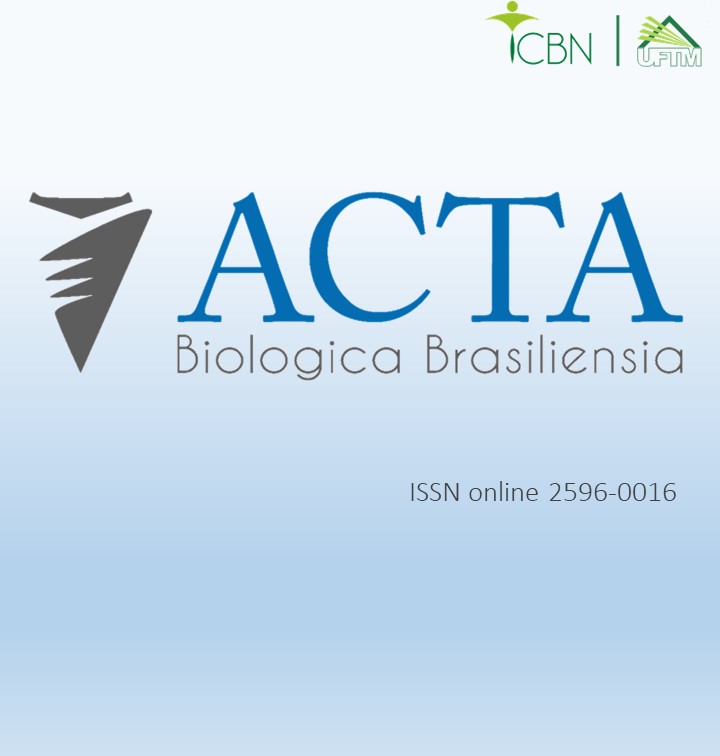COLETA NOTURNA DE INSETOS UTILIZANDO ARMADILHAS LUMINOSAS EM ÁREA URBANA NA CIDADE DE UBERABA/MG
DOI:
https://doi.org/10.18554/acbiobras.v7i1.7655Palavras-chave:
armadilha de queda, captura de insetos, levantamento entomofaunístico, eficácia de armadilhas, entomologia urbanaResumo
A iluminação artificial tem sido apontada como tendo efeitos adversos na fisiologia e comportamento de animais, incluindo insetos. Nesse sentido, o estudo a respeito da influência da luminosidade sob as diversas espécies faz-se necessário para observação dos efeitos causados e até mesmo de impactos negativos no meio ambiente. O principal objetivo para a realização dessa pesquisa foi verificar a eficácia de diferentes tipos de lâmpadas em armadilhas do tipo pitfall para coleta de insetos. A técnica de captura escolhida foi a coleta passiva, em que foram montadas previamente armadilhas luminosas, e preservação temporária por via líquida, para a atração e retenção. Foram coletados 25 insetos pertencentes às ordens Hemiptera, Diptera, Hymenoptera, Trichoptera e Psocoptera. Após análise dos resultados, observou-se uma maior eficiência da armadilha de queda que utilizou lâmpada de luz fluorescente compacta branca morna, a qual obteve mais insetos capturados. Utilizando o método Qui-Quadrado o resultado foi significativo para todos os grupos no nível de 1%, ou seja, a probabilidade que a diferença observada entre o tratamento seja ao acaso é inferior a 1%. Foi possível concluir que a coleta de insetos se apresentou efetiva, possibilitando um estudo sobre a atratividade. Mas para que seja possível chegar a maior compreensão dos padrões de distribuição e abundância dos grupos de insetos, é necessário que sejam realizadas mais coletas, incluindo outras estações do ano e, em diferentes condições ambientais.
Referências
Owens, A; Lewis, S. The impact of artificial light at night on nocturnal insects: A review and synthesis. Ecology and Evolution. 2018; 8: 11337–11358. https://doi.org/10.1002/ece3.4557.
Firebaugh, A; Haynes, K. Light pollution may create demographic traps for nocturnal insects. Basic and Applied Ecology. 2019; 34: 118–125 https://doi.org/10.1016/J.BAAE.2018.07.005.
Araújo GH de; Pelli. A. Tabela de vida estática para Dermestes maculatus DeGeer, 1774 em laboratório, criado com dieta em carne branca – curimba, Prochilodus lineatus (Valenciennes, 1837). Braz. J. Anim. Environ. Res. 2024; 7(1): 464–478. https://doi.org/10.34188/bjaerv7n1-035.
Martins-Neto, FF; Mateus, MV; Biscalquin, AC; Luz, AM; Barboza, FR; Amorim, HPC; Goncalves, JCSI; Custodio, VB; Costa, WR; Pelli, A. Influência do ambiente na comunidade de macroinvertebrados bentônicos no Rio Uberaba/MG. Revista do Instituto de Ciências da Saúde (UNIP). 2022; 40: 225–231.
Macedo, RM; Neves, NM; Sabino, RM; Pelli, A. Insetos na alimentação humana: avaliação sensorial de barras de cereais com Tenebrio molitor Linnaeus, 1758. Acta Biologica Brasiliensia. 2022; 5(1): 75–86. https://doi.org/10.18554/acbiobras.v5i1.7202.
Pelli-Neto, A; Hayashi, C; Oliveira, GB; Pimenta, PC; Pelli, A. Application of artificial neural networks in estimating the number of species in benthic communities. International Journal of Hydrology / MedCrave, 2021; 5: 182–190. https://doi.org/10.15406/ijh.2021.05.00279
Silva, ACB; Pelli, A. Avaliação da repelência de Allium sativum, l. (alho) visando o controle de Nauphoeta cinerea (Olivier, 1789). Acta Ambiental Catarinense, 2021; 19: 1–7, https://doi.org/10.24021/raac.v19i1.6225.
Kharouba, H; Lewthwaite, J; Guralnick, R; Kerr, J; Vellend, M. Using insect natural history collections to study global change impacts: challenges and opportunities. Philosophical Transactions of the Royal Society B. 2018; 374: 20170405. https://doi.org/10.1098/rstb.2017.0405.
Anderson, J. Malaise-type traps used for catching flies of veterinary entomological significance. Annals of the Entomological Society of America, 2022; 115: 325–325. https://doi.org/10.1093/aesa/saac009.
Morewood, W, Hein, K, Katinic, P, Borden, J. An improved trap for large wood-boring insects, with special reference to Monochamus scutellatus (Coleoptera: Cerambycidae). Canadian Journal of Forest Research, 2002; 32: 519-525. https://doi.org/10.1139/X01-224.
Silva, LN; Amaral, AA. Amostragem da mesofauna e macrofauna de solo com armadilha de queda. Revista Verde de Agroecologia e Desenvolvimento Sustentável, 2014; 8 (5): 108–115. https://www.gvaa.com.br/revista/index.php/RVADS/article/view/1988.
Silva, ACB; Pelli, A. Estado atual do conhecimento das Baratas, Order Blattaria Burmeister, 1829. Revista Uningá, 2019; 34: 28–38. https://revista.uninga.br/uningareviews/article/view/2950/2151.
Relyea, R; Ricklefs, RE. A Economia da Natureza. 8ª ed. Rio de Janeiro: Guanabara Koogan, 2021.
Camelo, PTL; kellermanni, RCS. Uso de fotoprotetores na prevenção de danos por exposição solar: conceitos, avaliação histórica e recomendações. Scire Salutis. 2021; 11(2): 171–180. http://doi.org/10.6008/CBPC2236-9600.2021.002.0020.
Pelli A, inventor; Universidade Federal do Triângulo Mineiro, cessionária. Armadilha luminosa e aderente para insetos. Patente do Brasil BR2020150253970 (INPI). 12 de setembro de 2017.
Borror, D; Delong, D. M. Introdução ao estudo dos insetos. São Paulo: Editora Edgard Blücher Ltda e Editora da Universidade de São Paulo. 1969.
Lara, FM. Princípios de entomologia. São Paulo. Editora Ícone Ltda. 1992.
Gullan, PJ; Cranston, PS. The Insects. An Outline of Entomology. New Jersey: Wiley-Blackwell. A John Wiley & Sons, Ltd., Pulication; 2010.
Rafael, JA. Insetos do Brasil: Diversidade e Taxonomia. Ribeirão Preto: Editora HOLOS; 2012.
Sanders, D; Gaston, KJ. How ecological communities respond to artificial light at night. J. Exp. Zool. Part A Ecol. Integr. Physiol. 2018; 329: 394–400. https://doi.org/10.1002/jez.2157.
Owens, ACS; Lewis, SM. The impact of artificial light at night on nocturnal insects: A review and synthesis. Ecology and Evolution, 2018; 8: 11337–11358. https://doi.org/10.1002/ece3.4557.
Shimoda, M, Honda, K. Insect reactions to light and its applications to pest management. Appl Entomol Zool. 2013; 48: 413–421.
Silva, ACB; Pelli, A. Estado atual de conhecimento de dinâmica de populações. Ensaios e Ciência (Campo Grande). 2019; 23: 256–261. http://dx.doi.org/10.17921/1415-6938.2019v23n3p256-261.
Silva, ACB; Pelli, A. Ciclo Circadiano para Nauphoeta cinerea (Olivier, 1789) (Blattodea, Blaberidae) em condições climatizadas de laboratório. Revista Brasileira de Desenvolvimento, 2020; 6: 65437–65444.
Silva, ACB; Pelli, A. Avaliação da repelência de Allium sativum, l. (alho) visando o controle de Nauphoeta cinerea (Olivier, 1789). Acta Ambiental Catarinense. 2021; 19: 1–7, https://doi.org/10.24021/raac.v19i1.6225.
Yeates, D, Wiegmann, B. Congruence and controversy: toward a higher-level phylogeny of Diptera. Annual review of entomology, 1999; 44: 397-428. https://doi.org/10.1146/ANNUREV.ENTO.44.1.397.
Milhomem, MS; Mello, FZV; Diniz, IR. Técnicas de coleta de besouros copronecrófagos no Cerrado. Pesquisa Agropecuária Brasileira, 2003; 38(11): 1249–1256.
Deus, J, Mucci, L, Reginatto, S, Pereira, M, Bergo, E, Camargo-Neves, V. Evaluation of Methods to Collect Diurnal Culicidae (Diptera) at Canopy and Ground Strata, in the Atlantic Forest Biome. Insects, 2022; 13(2): 202. https://doi.org/10.3390/insects13020202.






